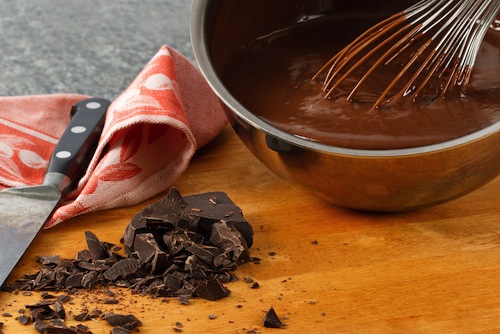FREE SHIPPING ON ORDERS OVER $75
Cooking with Chocolate: Melting Temperature
Many home cooks believe that cooking with chocolate is a mystery only a select few know. However, the truth is that creating culinary confections from chocolate is easy once you understand certain basics. Home cooks commonly fail to temper chocolate properly, which can result in unattractive clumping or streaking. Following are the basics on how to melt chocolate so that it turns out smooth and glossy.
Melting Dark Chocolate On the Stove
Always use a double boiler when melting chocolate on the stovetop –this will help keep it from scorching if the temperature inadvertently becomes too high.
- Chop one pound of chocolate with a serrated knife. Combine 3/4 of it with two tablespoons of shortening or lard in the top of a double boiler.
- Allow the water to reach the simmering point and adjust the heat to hold it steady.
- Allow the mixture to reach 100 degrees F and remove the double boiler bowl from the stove.
- Place the bowl in a larger bowl containing cold water and stir in the rest of the chocolate.
When the mixture reaches 82 degrees F, place it back over the simmering water and bring it to 90 degrees F. Congratulations! You’ve just created the perfect dipping chocolate for candy making.
Melting Milk Chocolate and White Chocolate
Because both milk chocolate and white chocolate are more delicate than dark chocolate, a lower temperature needs to be used during the melting process when working with either of these. A general rule is that temperatures should be two degrees less than what would be used for dark chocolate. For instance, instead of allowing a milk or white chocolate mixture to reach 100 degrees F, it should be removed from the double boiler when the thermometer says 98 degrees F.
- Temperatures should never exceed 100 degrees F when melting any type of chocolate.
- When working with chocolate in your home kitchen, always use the best quality that you can. High-quality chocolate has larger amounts of cocoa butter than its inferior counterparts, which makes it melt more evenly.
- Investing in a good digital candy thermometer will prevent many accidental temperature mishaps. A degree or two really does make a difference when making candy.
Always keep the fan above the stove turned on high to keep steam from condensing in the bowl where the chocolate is melting. Even a small amount of water in the bowl will cause the chocolate to develop into a stiff paste.
You can spread a small amount of chocolate onto the flat surface of a saucer to tell if it’s properly tempered. If it dries quickly with a glossy finish, you’ve successfully mastered the fine art of cooking with chocolate.
Did you know you can also use sugar free Asher’s Chocolate for baking?
